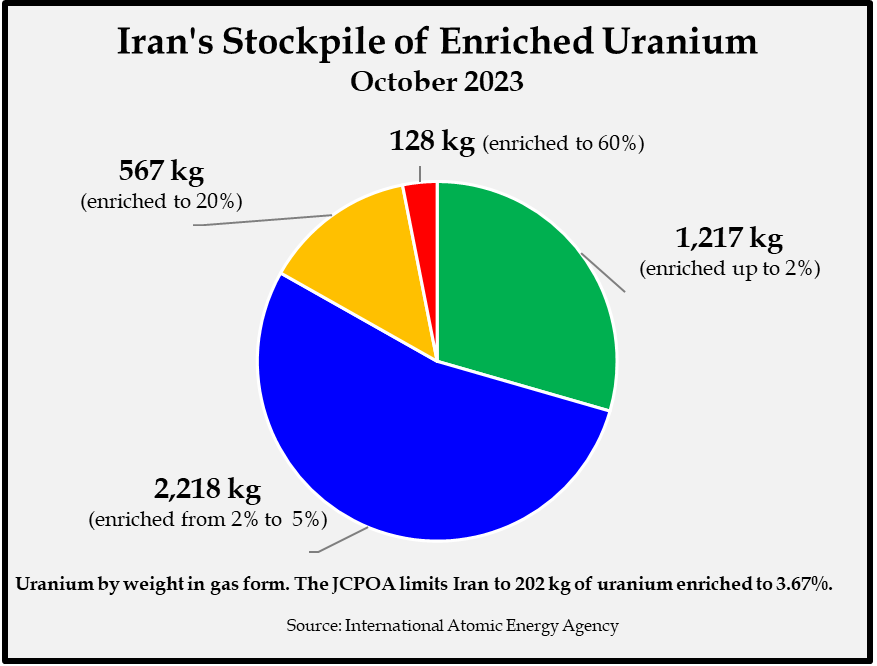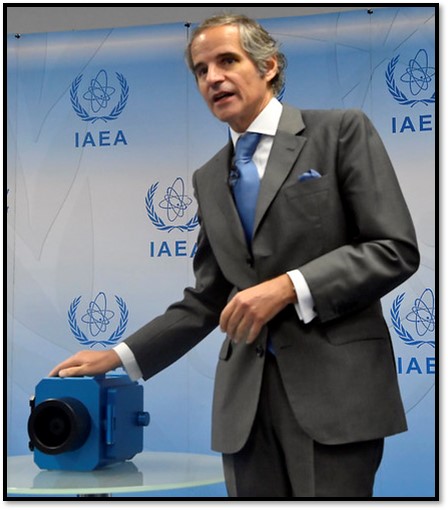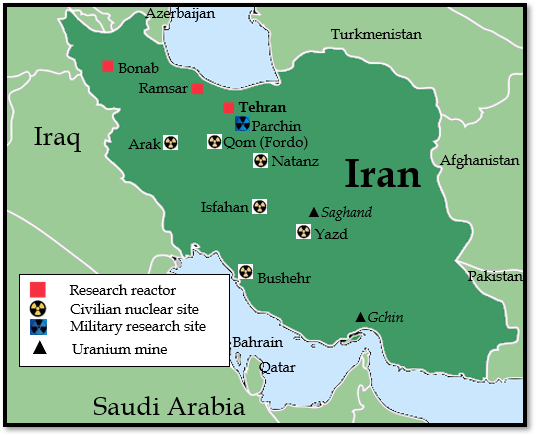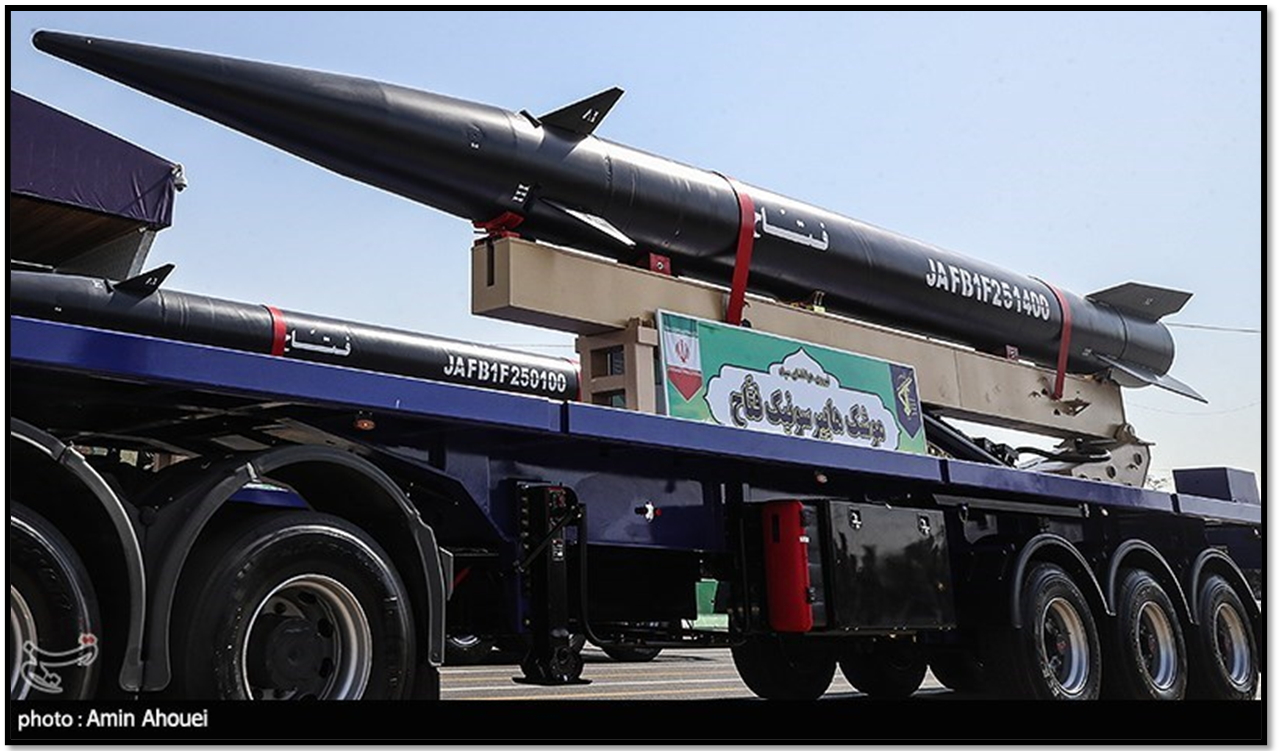What was the status of Iran’s nuclear program at the end of 2023? Given the way Tehran has accelerated its program in the past, what are the biggest dangers of further advances in 2024?
Overall, Iran's nuclear program continued to trend in the wrong direction. During 2023, the proliferation risks posed by Iran's nuclear program grew primarily because Tehran continued to increase its stockpiles of uranium enriched to 60 percent. Iran can much more quickly enrich this material to weapons grade levels, which is considered 90 percent. Iran has not made the political decision to produce nuclear weapons, according to Western and Israeli intelligence, but as its stockpiles of highly-enriched uranium grow, Tehran would need less and less time to produce fuel for a handful of nuclear weapons.
Tehran also did little to enhance transparency, which complicate any potential diplomacy to curb Iran’s nuclear program. As the gaps in monitoring grow, the International Atomic Energy Agency (IAEA), the U.N. watchdog, will find it more difficult to reconstruct the history of Iran's nuclear activities and establish baseline inventories on certain activities, such as the number of centrifuges produced, if a future deal is reached.
 But Tehran did take some steps, particularly in the latter half of 2023, which may indicate an intention to de-escalate nuclear tensions. For example, Iran slowed the rate at which it produced uranium enriched to 60 percent. The time needed to produce fuel for multiple nuclear weapons was still shrinking but not as rapidly. Iran also took some limited steps to enhance monitoring. It allowed the IAEA to install enrichment monitors at two of its uranium enrichment facilities. The equipment should provide the agency with more rapid indication if Tehran decides to enrich uranium to weapons grade.
But Tehran did take some steps, particularly in the latter half of 2023, which may indicate an intention to de-escalate nuclear tensions. For example, Iran slowed the rate at which it produced uranium enriched to 60 percent. The time needed to produce fuel for multiple nuclear weapons was still shrinking but not as rapidly. Iran also took some limited steps to enhance monitoring. It allowed the IAEA to install enrichment monitors at two of its uranium enrichment facilities. The equipment should provide the agency with more rapid indication if Tehran decides to enrich uranium to weapons grade.
Iran also did not follow through on certain plans that would have increased the proliferation risk. In late 2022, Iran had announced its intention to significantly expand centrifuge installation at the Fordo uranium enrichment facility. Yet Iran did not install any additional centrifuges, which spin uranium gas at a high rate to enrich it, at Fordo in 2023. If it had installed additional advanced IR-6 centrifuges at the underground site, the proliferation risk would have significantly increased because the deeply buried site would be difficult to target with conventional military strikes.
These moves did not do anything to limit proliferation risk in the short term. But they could signal Iran's willingness to take further steps if the United States is willing to take reciprocal steps to stop the cycle of escalation.
What are the potential compromises or options for de-escalation in 2024? What steps might Iran be willing to take—and in exchange for what from the United States or the International Atomic Energy Agency (IAEA)? What are the prospects of movement? And what are the dangers without movement?
In 2024, the U.S. focus should be on increasing the monitoring and oversight of Iran's nuclear program. Negotiating a future deal will get more and more difficult the longer the monitoring gap persists. Increased monitoring also reduces the likelihood of Washington miscalculating Tehran’s intentions.

The United States could incentivize Iran to allow the IAEA — the U.N. nuclear watchdog — to reinstall monitoring equipment at facilities that it has not accessed since 2021 and to provide the IAEA with data from those facilities recorded between February 2021 and June 2022. And the United States could also incentivize Iran to allow inspectors limited access to those facilities. Together, these changes would allow the IAEA to begin to reconstruct the history of Iran’s program, and work towards new baseline inventories that could be used in a future deal to verify limits.
Tehran does not appear to be interested in negotiating a more comprehensive nuclear agreement until after the U.S. presidential election in 2024. But it could consider steps that would limit proliferation risk in the short term and limit its acquisition of new knowledge. Agreeing to limit deployment of new advanced centrifuges would help because that kind of research and development cannot be reversed and would therefore complicate a future deal. Iran could also reduce the risks posed by its highly enriched uranium stockpiles by converting uranium gas to powder form so it cannot be quickly enriched to higher levels. Or Iran could cap its stockpiles of uranium gas enriched to 60 percent and 20 percent. These steps would create time and space for talks down the road and prevent the nuclear crisis from intensifying.
In exchange, the United States could free up more of Iran’s frozen funds held abroad and allow them to be transferred to the accounts in Qatar, which can only be used for purchasing humanitarian goods, such as food, medicine and agricultural products. The United States could agree not to pursue any additional nuclear related sanctions or perhaps allow some limited oil sales to provide Iran with immediate benefits as well.
In the meantime, Iran has very little room to ratchet up its nuclear program without risking an Israeli or U.S. response. So, the risk of miscalculation will remain high in 2024 absent efforts to de-escalate.
Since 2021, Iran has limited the ability of the IAEA to monitor key aspects of its program. What is needed in 2024 to ensure the world knows the full scope of Iran’s advances—to catch up on missed monitoring in the past and ensure it has full knowledge moving forward?
Since 2021, Iran has blocked IAEA access to certain nuclear facilities that support the nuclear program, like centrifuge production facilities, and uranium mines. IAEA Director General Rafael Mariano Grossi has warned that the gap in monitoring made it impossible to reestablish reliable baseline inventories for certain materials, like centrifuge components, to verify limits under the JCPOA. Grossi said the IAEA will need to work with Iran to establish new baselines. Without accurate and reliable baseline information, the IAEA will have a hard time credibly saying that Iran has not diverted materials from those facilities to a covert program and verifying limits in a future deal. To allow the IAEA to begin establishing new baselines, Iran would need to allow the IAEA to reinstall monitoring equipment at certain facilities and analyze data recorded between February 2021 and June 2022.
 Increased IAEA access also deters diversion. As Iran develops increasingly advanced centrifuges that enrich uranium more efficiently, detecting a covert program will be more difficult. Iran would only need to divert a small number of newer models compared to the first-generation IR-1 centrifuges, which were inefficient and accident-prone. An IR-6 is roughly four to six times more efficient than an IR-1 centrifuge. Expanding IAEA access to facilities such as the centrifuge production workshops would provide greater assurance that Iran is not diverting materials for illicit activities.
Increased IAEA access also deters diversion. As Iran develops increasingly advanced centrifuges that enrich uranium more efficiently, detecting a covert program will be more difficult. Iran would only need to divert a small number of newer models compared to the first-generation IR-1 centrifuges, which were inefficient and accident-prone. An IR-6 is roughly four to six times more efficient than an IR-1 centrifuge. Expanding IAEA access to facilities such as the centrifuge production workshops would provide greater assurance that Iran is not diverting materials for illicit activities.
Given Iran’s recent advances in missiles and drones, what are the next steps it might take to develop either program? With what goals?
Iran appears intent on diversifying its stockpile of missiles and drones to expand its options to deter regional rivals. In 2024, Iran will likely continue to focus on the precision of its missiles and the development of longer-range systems that are designed to hit moving targets, such as ships. Iran also expressed interest in hypersonics. It is unlikely that Iran will take steps to significantly extend the range of ballistic missiles. Iran can target regional rivals, such as Israel, using its existing systems. So, Iran does not have a compelling need to develop an intercontinental ballistic missile. But Iran is interested in space capabilities. And Tehran is likely to continue developing more powerful space launch vehicles, which have technology that can be applied to longer range ballistic missiles.

In October 2023, the U.N. restrictions that limited Iran’s research, development, and production of ballistic missiles—including some capable of delivering nuclear weapons—expired. What are the implications or dangers for 2024? What’s your sense of Iran’s intentions?
Iran had long flouted the missile restrictions included in U.N. Security Council Resolution 2231, which enshrined the 2015 nuclear deal. The sanctions may have slowed the growth of Iran’s program and prevented exports of certain systems, but they were ineffective in halting proliferation. Iran continued to illicitly transfer systems and technologies to non-state actors like the Houthis in Yemen and Hezbollah in Lebanon. It also sold drones to Russia in violation of the resolution and reportedly worked to build a drone manufacturing plant in Russia. Iran has also transferred drone production expertise to Venezuela and Tajikistan despite the restrictions.
The impact of the expiration on Iran's proliferation of missiles and drones likely will be minimal. Iran will continue to supply its proxies in the region with missile systems and provide drone support to partners such as Russia, but it is unlikely to become a state supplier of ballistic missile systems. U.S. and European sanctions were still a deterrent for most states to buy systems from Iran. And while the U.N. sanctions have expired, there is still an option to snap back the U.N. restrictions for another two years or until October 2025. Iran was unlikely to increase missile sales to Russia because the Europeans would view that as a provocation and could trigger a snapback of sanctions at the U.N. Security Council.
Kelsey Davenport is the Director for Nonproliferation Policy at the Arms Control Association.
Photo Credits: IAEA via Flickr [CC BY 2.0]; Raisi via President.ir; Fatah missile via Tasnim News Agency (CC BY 4.0)
